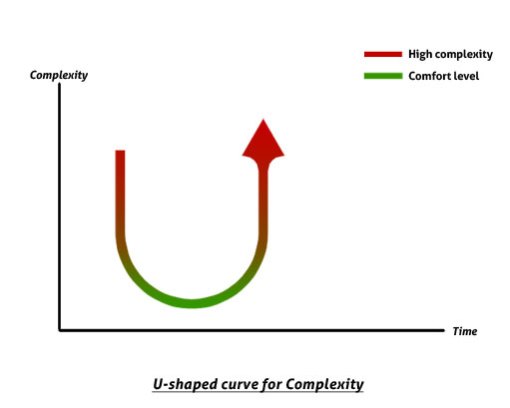The Paradox of Technology.
Technology is how people modify the natural world to suit their own purposes. We tend to invent or modify something so that new/modified technology can make our life easier and more enjoyable, providing more and more benefits. But paradoxically, adding new complexities gives rise to new difficulties and thus increase in frustration.
The U-shaped curve(as shown above) suggested by Donald Norman, in his book The Design of Everyday Things, explains that new technology tends to follow this curve of complexity: starting high; dropping to a low, comfortable-level; then climbing again. New devices are complex and need much effort to learn their usage, as the maturity level of industry and users increases these devices becomes much more simpler, reliable and easy. But when industry reaches a stable point of the maturity, new users figure out how to add increased power and capability, and this always happens at the cost of added complexity and sometimes decreased in reliability.
I will take an example of Watch. Earlier the watches were simple, all you have to do was set the time and them wound. The Stem, a knob at the side of the watch, was the only standard control. Turn the knob to wound the spring and so the work works well. To make the setting, pullout the knob and turn the hands of the watch to set your time. Easy operations, simple and no complexities.
Now consider the watches, that are available in the present market, Digital Watch. New technology which replaced the old spring by a motor run by long-lasting batteries. So no turning of the knob to wound the spring, just setting the time was the only task. Also there is addition to the new functionalities like: watch can give the day of the week, the month, the year, the alarm, stop watch, calculator, counter, different time zones, etc. But these all added functionalities cause problem: How do you design a device(watch) that has so many functions while trying to reduce the cost and complexity of the device(watch)and also the workable control buttons? No easy answers to these. Because whenever the number of controls are less then the required operations and number of functions, the design becomes complex and harder to learn the usage, thus unnatural design. “The same technology that simplifies the life by providing more functions in each device also complicates life by making the device harder to learn, harder to use”(Donald Norman).
Like watch there are many more examples like Radio, TV, automobiles, etc. which can be used to show the paradox of technology But its not like that we have to blame the technology for any poor design, by using and following the principles of good design we can manage the complexities of the device. So added complexity and difficulty cannot be avoided when functions are added, but with clever design, they can be minimized. .
____________________________________________________________________________________________
So this is it from my side, now its your turn to yep. Feel free to add comments. Let’s share pretty things! Know more about my work @ www.yagneshahir.in

